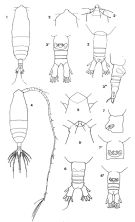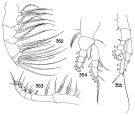|
|
 |
|
Calanoida ( Order ) |
|
|
|
Arietelloidea ( Superfamily ) |
|
|
|
Augaptilidae ( Family ) |
|
|
|
Haloptilus ( Genus ) |
|
|
| |
Haloptilus paralongicirrus Park, 1970 (F,M) | |
| | | | | | | Ref.: | | | Park, 1970 (p.478, 537, Descr.F, figs.F); Matthews, 1972 (p.53, Rem.); Roe, 1975 (p.347, Descr.M, figs.M, Rem.); Saraladevi, 1977 (p.41); Park, 1988 (p.22, Descr.F, figs.F, Rem.); Razouls, 1994 (p.195, fig.F) |  Comparison between H. longicirrus and H. paralongicirrus issued from T. Park (1970, 1988). Haloptilus longicirrus Female: 1, habitus (dorsal view); 2 & 2', Head (dorsal, ventral, respectively); 3, 3', 3'', Urosome (dorsal, ventral, lateral, respectively) . Haloptilus paralongicirrus Female: 4, dorsal view; 5 & 5', Head (dorsal, ventral, respectively); 6 & 6', Urosome (dorsal, ventral, respectively); 7 & 7', genital segment (lateral, ventral, respectively).
|
 issued from : T. Park in Antarct. Res. Ser. Washington, 1988, 47. [p.23, Fig.14]. Female (from W Australia: 38°26'S, 115°19'E) : a, forehead (dorsal); b, urosome (ventral); c, genital segment (ventral); d, idem (lateral left side). Nota: Rostral filaments well developped. Prosome about 5 times length of urosome. 2nd urosomal segment longer than 3rd. A1 about twice length of body.
|
 Issued from : T. S. Park in Bull. Mar. Sc., 1970, 20 (2). [p.536, Figs.343-351]. Female (from Caribbean Sea & G. of Mexico): 343, habitus (dorsal); 344, forehead (dorsal); 345, idem (ventral); 346, urosome (dorsal); 347, genital segment (ventral); 348, A2; 349, Md; 350, Md (biting edge of the mandibular blade); 351, Mx1. Nota: Forehead in dorsal view broadly rounded without a distinct projection. A1 exceeding end of caudal ramus by lest 10 segments. Urosome about 1/5 length of prosome; Genital segment as wide as long, with two spermathecae widely separated. Basis of Mx1 usually with 4 or occasionally 5 setae. Caudal ramus about twice as long as wide.
|
 Issued from : T. S. Park in Bull. Mar. Sc., 1970, 20 (2). [p.538, Figs.352-355]. Female: 352, Mx2; 353, Mxp; 354, P1 (anterior); 355, P5 (anterior). Nota: P5: coxa with a small internal seta, first two exopodal segments usually without internal setae,basis with a long external seta.
|
 issued from : H.S.J. Roe in Bull. British Mus. (Natural History) Zool., London, 1975, 28 (7). [p.348, Fig.24]. Male (Cape Verde Islands): a, thorax and urosome (dorsal); b, forehead (dorsal); c, rostrum (right lateral side); d, rostrum (ventral); e, A1 (segments 15-20); f, A2; g, mandibular palp; h, masticatory edge of Md; i, Mx2; j, Mxp; k, P1; l, P2; m, P5 (different specimen). Bar scale 0.1 mm unless indicated.
| | | | | Compl. Ref.: | | | Brenning, 1985 a (p.28, Table 2); 1986 (p.14, Rem.); Madhupratap & Haridas, 1986 (p.105, tab.1); Ambler & Miller, 1987 (tab.2, 3); Errhif & al., 1997 (p.422); Shih & Young,1995 (p.68); Padmavati & al., 1998 (p.347); Hsiao & al., 2004 (p.325, tab.1); Kazmi, 2004 (p.227); Dur & al., 2007 (p.197, Table IV); Williamson & McGowan, 2010 (p.273, Table 3, Pacific central gyres: N and S); Schnack-Schiel & al., 2010 (p.2064, Table 2: E Atlantic subtropical/tropical); Medellin-Mora & Navas S., 2010 (p.265, Tab. 2); Hsiao S.H. & al., 2011 (p.475, Appendix I) | | | | NZ: | 6 | | |
|
Distribution map of Haloptilus paralongicirrus by geographical zones
|
| | | | | | | | |  issued from : K. Saraladevi in Proc. Sympos. warm water Zooplankton, 1977, special publ. [p.44, Fig.3]. issued from : K. Saraladevi in Proc. Sympos. warm water Zooplankton, 1977, special publ. [p.44, Fig.3].
Distribution map for H. paralongicirrus and H. bulliceps |
| | | | Loc: | | | South Africa (E), Cape Verde Is., Mauritania, Caribbean Sea, Caribbean Colombia, G. of Mexico, Arabian Sea, S Indian (convergence subtropical), Bay of Bengal, W Australia, China Seas (South China Sea), Taiwan (SW, E), off NE Hawaii, Pacific (central gyres: N and S), SW Australia.
Type locality: 19°02'N, 81°57'W. | | | | N: | 16 | | | | Lg.: | | | (8) M: 2,2-1,67; (88) F: 2,64-2,36; (312) F: 2,6; (928) F: 2,31-2,7; (1108) F: 2,45; 2,67; {F: 2,31-2,70; M: 1,67-2,20} | | | | Rem.: | epi-mesopelagic. Taken from the caribbean Sea at a depth between 100 and 1850 m (Matthews, 1972).
This species is very close to H. longicornis and H. longicirrus. The females differ from those of H. longicirrus by the form of the head and their inferior size. Also, the species lives not as deep as H. longicirrus. For Park, the slight differences could be due to a simple variation caused by their different vertical distribution patterns. H. longicornis is the most "shallow" of the three species. It is noted that these three species do not show vertical migrations.
Park (1970, p.537) points to the anatomical details of appendages of this species is almost indistinguishable from H. longicirrus Brodsky (1950). The two species are separable by obvious differences in the body size and the shape of the forehead, although, until the entire range of their distribution and morphological variability is known, it cannot be determined whether these differences involve specific character or simply ecophenotype variations caused by the differences in their geographical and vertical distributions. | | | Last update : 07/12/2020 | |
|
|
 Any use of this site for a publication will be mentioned with the following reference : Any use of this site for a publication will be mentioned with the following reference :
Razouls C., Desreumaux N., Kouwenberg J. and de Bovée F., 2005-2024. - Biodiversity of Marine Planktonic Copepods (morphology, geographical distribution and biological data). Sorbonne University, CNRS. Available at http://copepodes.obs-banyuls.fr/en [Accessed April 25, 2024] © copyright 2005-2024 Sorbonne University, CNRS
|
|
 |
 |








